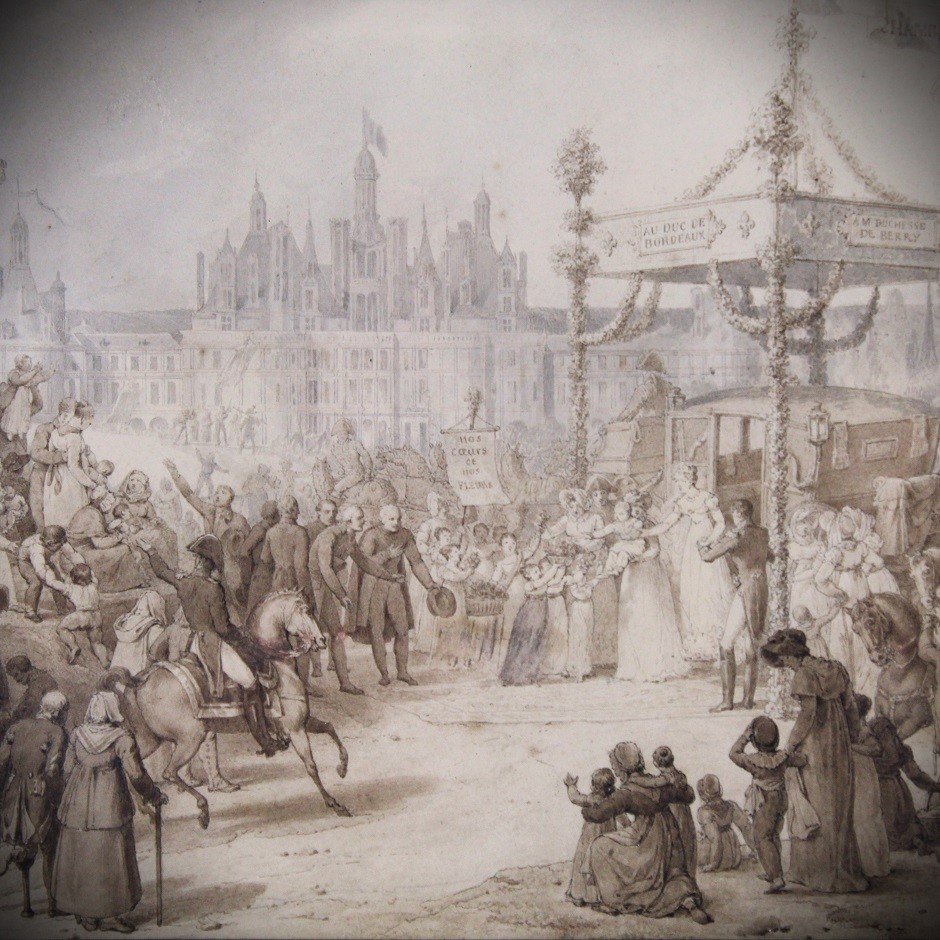Jean-Baptiste Isabey (1767-1855)
Demande d'informations
| Black chalk, pen and brown ink, grey and brown wash |
| 20,5 x 30 cm |
| Signed and dated in pen and brown ink at bottom left J. Isabey. 1821 |
| Provenance : |
| From the album of H.R.H. the Duchess of Berry |
| René Fribourg |
| Anonymous sale, Sotheby's, London, 16 October 1963, lot 568 |
| Anonymous sale, Christie's, London, 21 November 1996, lot 34 |
| Hubert Guerrand-Hermès Collection sale, Autour de la duchesse de Berry, Sotheby's, Paris, 15 December 2023, lot 588 |
More info
In the night of 13 to 14 February 1820, Charles-Ferdinand d'Artois, Duke of Berry, was assassinated by Bonapartist Louis-Pierre Louvel, driven by the desire to ‘destroy the Bourbon line’. His widow, Marie-Caroline of the Two Sicilies, already the mother of a daughter and pregnant at the time of the tragedy, gave birth seven and a half months later to a son, the long-awaited heir to the throne.
Thus was born Henri Charles Ferdinand Marie Dieudonné d'Artois, Duke of Bordeaux, better known by his courtesy title of Count of Chambord and dubbed the ‘miracle child’ by the poet Alphonse de Lamartine.
On 11 October 1820, a national subscription enabled the prince to be given the Château de Chambord.
Produced for the Duchess of Berry, this decidedly festive drawing commemorates the arrival of the Duke of Bordeaux at Chambord shortly after his birth.
With his characteristic impressive meticulousness, Isabey composes a scene teeming with details, brought to life at the gates of the estate, while the imposing castle stands majestically in the background.
The Duchess of Berry, getting out of the carriage, holds the hand of the Duke of Bordeaux, carried by another woman, to present him to the people. A crowd of people of all ages and conditions, soldiers, children, beggars, the wounded, clergymen and musicians have come to acclaim the pretender to the throne. A group of little girls under a banner bearing the touching words ‘Our hearts and our flowers’ paid homage to their future king by offering him bouquets. In the foreground, a makeshift restaurant had been set up, with the name ‘Aux Bienvenus’ written on a sign, adding a touch of spontaneity to the event.
This work was subsequently engraved in 1821 by Jean-Baptiste Isabey himself and dedicated to Her Royal Highness the Duchess of Berry.
Jean-Baptiste Isabey, trained in history painting by Jacques-Louis David, made a name for himself during the Revolution as a miniaturist and draughtsman. Taking advantage of a favourable context for the dissemination of accessible portraits, he imposed his sober and realistic style. A close friend of Joséphine de Beauharnais, he became one of the most influential portrait painters under the Directoire and played a key role under Napoleon, producing several official works. Thanks to the titles and positions he accumulated, he achieved major artistic recognition.
His former Bonapartist commitments slowed his rise during the Restoration, and he then turned to watercolour and lithography. He excelled in this field, as our drawing shows.
Avis
Aucun avis n'a été publié pour le moment.







